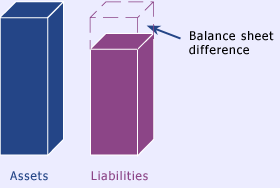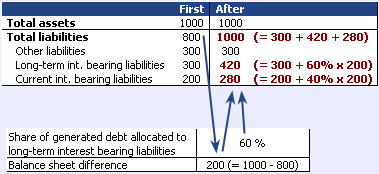
There are three parameters that you have to input:
- Minimum level of interest bearing long-term liabilities
- Minimum level of interest bearing current liabilities
- Share of debt allocated to long-term (interest
bearing) liabilities
You may also leave the first two parameters to be zero.
In this case the company do not necessary have any interest
bearing debt at all. If you leave the third parameter
to zero, all the generated debt are allocated to interest
bearing current liabilities.
At first, the model calculates the difference of assets
and liabilities. In this phase your minimum level requirements
have already been taken into account. Then the model simply
allocates the balance sheet differences to long-term and
current liabilities according to what you have determined
the share to be.
Here is an example what happens when assets are estimated
to be bigger. You do not actually see this happening,
it is just the logic behind the model.

|

















